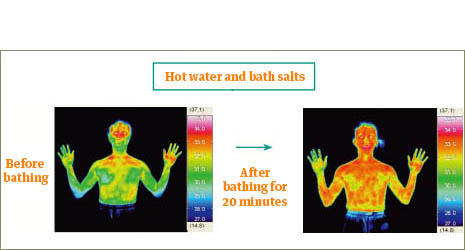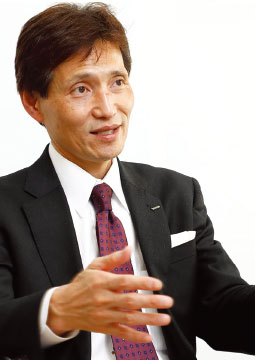Home > Highlighting JAPAN > Highlighting Japan March 2019 > From Hot Springs to Art: Japan’s Bath Culture
Highlighting JAPAN


Bath Salts: The Healthy Instant Upgrade to Home Bathtubs
The Japanese love to soak in hot springs and the tub at home, so it’s no surprise that they’re big fans of bath salts. Yasuhiro “Dr. Bath” Ishikawa, the head of PR at Bathclin Corporation—the first company to manufacture bath salts in Japan—speaks about the history and characteristics of this bath-time enhancer.
The first bath salts in Japan were marketed in 1897. According to Yasuhiro Ishikawa of Bathclin Corporation, however, that product was a fluke. “At the time, the company’s flagship product was herbal medicine for women containing sixteen natural remedies, an infusion that had a body-warming effect. A worker happened to suggest that steeping the leftover ingredients and using them to infuse bathwater might also have a warming effect. After trying it out, they found this infusion helped bathers retain body heat and healed rashes. When founder Jusha Tsumura heard about this, he refined the formula and began selling the result as bath salts. At the time, however, the majority of consumers were public bathhouses, not families with tubs at home.”
In 1930 they began selling the bath salt product known as Bathclin, which combines hot spring salts and pleasing fragrances, expanding the market still further. The number of homes with indoor baths rose during the postwar period of rapid economic growth, and with commercials urging consumers to “get the hot springs experience in your very own home” the product became a huge hit.
Other companies entered the market, and bath salts began to evolve and diversify. With products boasting everything from carbon dioxide gas to medicinal, cooling and skincare enhancers, consumers were soon able to choose bath salts for home use based on their own preferences and needs. Of them all, the type that dominated the Japanese bath salts market were hot springs-inspired bath salts.
“Bathclin Corporation began to sell a series inspired by famous Japanese onsen in 1986,” explains Ishikawa. “From among the many hot springs all over Japan, we carefully selected famous waters that were possible to replicate, eliminating any with high levels of sulfur, salt, acid or high alkaline content that could damage bathtubs. One big hit was our version of Hokkaido’s Noboribetsu Karurusu Onsen, which has cloudy water. No other company in Japan had been able to re-create it before.” The catchphrase from Bathclin’s early ads became even more of a reality.
Japanese people now spend less time soaking in the bath than before. According to a study by chemical and cosmetics company Kao Corporation, bathing times have shortened from 11.5 minutes a day in 2005 to 9.7 minutes in 2017, or roughly 16 percent less. There also appears to be a trend prevalent among younger generations to shower instead, because they find bathing a chore. In response to this, Ishikawa says: “Showers do clean the body. However, they aren’t as effective in raising body temperature to boost immunity, prevent illnesses, maintain mental and physical health, and ensure good sleep.
“Moreover,” he continues, “staying hydrated, bathing in certain water temperatures and for set times can activate immune cells and increase heat shock proteins which delay the production of lactic acid. Top athletes have shown interest in the positive effects of bathing. People who are used to showering should soak in a bath at a temperature that feels comfortable for them for ten minutes.” Using bath salts will make bathing more fun and increase the benefits, Ishikawa advises.
© 2009 Cabinet Office, Government of Japan








